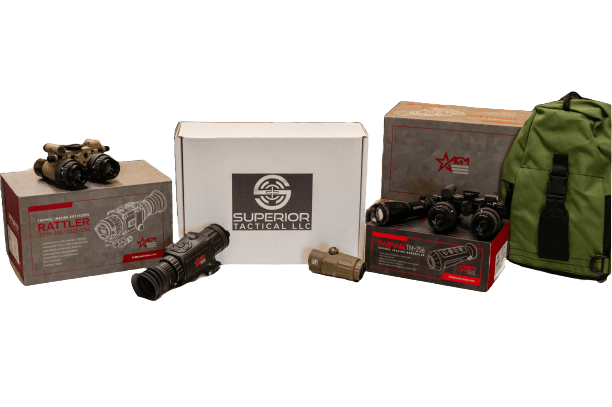Night Vision Technology Explained: Thermal Imaging vs. Digital Night Vision vs. Analog Night Vision

If you’ve ever found yourself stumbling around in the dark, wishing you had superhuman vision, you’re not alone. Night vision technology has made incredible strides, allowing us to see in low-light conditions. But with so many options out there, it can be challenging to understand the differences between thermal imaging, digital night vision, and analog night vision. Let’s break it down in simple terms and explore the technical details, as well as their practical applications.
Thermal Imaging
How It Works
Thermal imaging doesn’t rely on visible light but instead detects the heat (infrared radiation) emitted by objects. Every object above absolute zero (-273.15°C or -459.67°F) emits infrared radiation. Thermal cameras capture this radiation and convert it into an image, where different temperatures are represented by different colors.
Technical Details
- Sensor Resolution: Thermal imaging sensors come in various resolutions, commonly 320×240 or 640×480 pixels.
- Detection Range: High-end thermal devices can detect heat signatures at several kilometers.
- Color Palettes: Thermal images can be displayed in various color palettes like Black Hot, White Hot, and Rainbow, each suited for different environments.
Advantages
- Complete Darkness: Thermal imaging works in absolute darkness and doesn’t need any light source.
- Through Obstructions: It can see through smoke, fog, and light foliage, which is impossible for traditional night vision.
- Temperature Differences: Ideal for detecting temperature differences, making it useful for various applications.
Use Cases
- Military and Law Enforcement: For spotting hidden threats and conducting surveillance.
- Search and Rescue: Locating missing persons in challenging environments.
- Hunting: Detecting animals that are camouflaged or active at night.
- Home Inspection: Identifying heat leaks, electrical issues, or water damage.
Digital Night Vision
How It Works
Digital night vision devices use a CMOS sensor, similar to those found in digital cameras, to amplify available light. They convert light into an electronic signal, which is then processed to produce an image on a digital display.
Technical Details
- Sensor Resolution: Can vary but commonly found in resolutions like 640×480 or 1280×720 pixels.
- Display: Uses LCD or OLED screens to display the image.
- IR Illuminators: Often include built-in infrared (IR) illuminators to enhance visibility in near-total darkness.
Advantages
- Cost-Effective: Generally less expensive than thermal imaging.
- Day and Night Use: Can be used in daylight without damaging the sensor.
- Recording Capability: Many devices can capture photos and videos.
Use Cases
- Recreational Use: Ideal for camping, hiking, and wildlife observation.
- Security: Monitoring properties or perimeters.
- Boating and Navigation: Enhances visibility in low-light conditions.
Analog Night Vision
How It Works
Analog night vision, also known as image intensification, uses an image intensifier tube to amplify available light. It takes in ambient light and converts photons into electrons, which are then accelerated and converted back into light, creating a visible image on a phosphor screen.
Technical Details
- Generations: Night vision devices are categorized into generations (Gen 1, Gen 2, Gen 3), with Gen 3 offering the best performance.
- Resolution: Typically measured in line pairs per millimeter (lp/mm). Higher resolution provides clearer images.
- Light Sensitivity: Measures how well the device amplifies low levels of light.
Advantages
- High Sensitivity: Excellent performance in low-light conditions.
- Depth Perception: Provides better depth perception compared to digital night vision.
- Low Power Consumption: Generally uses less power than digital devices.
Use Cases
- Military: Widely used by armed forces for night operations.
- Hunting: Allows hunters to spot game without using a visible light source.
- Surveillance: Ideal for covert surveillance where stealth is crucial.
Comparing the Technologies
Performance in Darkness
- Thermal Imaging: Works in total darkness, detecting heat signatures.
- Digital Night Vision: Requires some ambient light or IR illuminators.
- Analog Night Vision: Amplifies ambient light but struggles in complete darkness without an IR source.
Image Clarity
- Thermal Imaging: Provides clear images based on temperature differences but may lack fine detail.
- Digital Night Vision: Offers decent image clarity, especially in higher resolutions.
- Analog Night Vision: Provides high-resolution images with excellent clarity and depth perception.
Durability and Reliability
- Thermal Imaging: Generally robust, but can be expensive and sensitive to extreme temperatures.
- Digital Night Vision: Durable and versatile but may suffer from digital noise.
- Analog Night Vision: Reliable and proven technology but more susceptible to light damage.
Cost
- Thermal Imaging: Typically the most expensive due to advanced technology.
- Digital Night Vision: More affordable, making it accessible for recreational use.
- Analog Night Vision: Varies widely, with Gen 1 being the most affordable and Gen 3 being the most expensive.
Which One Should You Choose?
Thermal Imaging
Choose thermal imaging if you need to detect heat signatures in complete darkness, through smoke, fog, or foliage. It’s ideal for search and rescue, hunting, and military applications.
Digital Night Vision
Digital night vision is a great all-around choice for recreational use, security, and navigation. It’s affordable and versatile, suitable for both day and night use.
Analog Night Vision
Analog night vision is perfect for those needing high-performance in low-light conditions without complete darkness. It’s widely used in military and hunting scenarios.
Conclusion
Understanding the differences between thermal imaging, digital night vision, and analog night vision can help you make an informed decision based on your specific needs. Each technology has its strengths and weaknesses, and the best choice depends on your intended use.
Whether you’re navigating through the wilderness, conducting a nighttime operation, or simply observing nocturnal wildlife, there’s a night vision solution for you. Embrace the advancements in night vision technology and choose the device that best suits your adventures.
